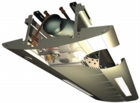Sustainability enablers

Many good reasons for the enthusiastic approval with which MSCBs are now being received — Terry Farthing.
Multi-service chilled beams address sustainable issues and are one of the most energy efficient terminal air-conditioning systems. Terry Farthing discusses these feature and comments on the increasing popularity of this system.Independent research organisation BSRIA estimates that the market for chilled beams grew by 33% in 2006 compared with 2005 and predicted further growth of 40% for last year. However, the all-embracing term chilled beam includes, of course, multi-service chilled beams (MSCBs), which in value terms is two to five times greater than a commodity beam. As such, the great surge in market value reported by BSRIA has been heavily influenced by the popularity of the MSCBs. Indeed, over the last five years, they have really come of age, with leading developers such as Land Securities and Stanhope acknowledging their benefits and installing them on increasingly large and prestigious projects, including speculative office developments. There are many good reasons for the enthusiastic approval with which MSCBs are now being received. One of the most important is related to their superb energy efficiency. MSCBs are the most energy-efficient terminal air-conditioning system. Compared to constant-speed fan-coil units, the saving in carbon emissions is around 15%. This in itself is a compelling reason to utilise this air-conditioning system. However, many other features are making this system popular — among them being the appeal of multi service chilled beams to the market. Sustainability is becoming another major influence in the selection of air-conditioning systems. With MSCBs, chilled-water temperatures are higher than usual, at 14ºC flow and 17ºC return, so renewable energy sources such as groundwater can be more effectively utilised. Another sustainability issue is the life of the building and system. Most pre-1970 office buildings have a low floor slab to soffit height. Traditional comfort-cooling solutions require a false ceiling, which reduces this height too much, so landlords tend to opt for expensive new build to ensure a modern office environment and sufficient space for the increased cabling and other services. However, MSCBs solve the space problem because they can be fitted directly to the soffit and left exposed, meaning that there is no need for a false ceiling and there is sufficient slab-to-soffit height is sufficient, even in refurbished buildings. Trox, for example, has supplied MSCBs successfully down to 2.8 m high which allows for a 100 mm false floor and no false ceiling. So MSCBs offer the opportunity to modernise and recycle older buildings — a more sustainable solution that also costs less and is available more quickly than a new building. MSCBs have no moving parts, no fans, no filters, so their life is much longer than a traditional air-conditioning system. Typically fan coils have a life of 15 to 20 years, compared with over 30 years for MSCBs. Product or system life is an important and often overlooked factor in the sustainability argument. As mentioned above, with exposed MSCBs there is no need to have a false ceiling. Most false ceilings in modern office buildings conceal an array of cables, pipes, ducting etc., which can now be incorporated into an architecturally designed raft. Anyone looking above a false ceiling would be amazed at the untidiness and dust and dirt that are allowed to accumulate above sophisticated machines and people who need a clean, controlled working environment. Although some developers and end clients opt for the MSCB solution there is still a perception that buildings must have a false ceiling. With energy sustainability and whole life costs becoming increasingly important this false ceiling taboo will be swept away. Offsite prefabrication of the beams has other significant sustainability benefits.

The precision with which aluminium can be extruded enables long runs of MSCBs to be installed with no obvious joins, ripple effect or alignment problems.
First, there is no over-ordering of the separate components that go into the MSCB since they are part of a just-in-time (JIT) process operated in the factory. Compared to on-site activities, waste through over ordering, damage etc. is more or less eradicated. Additionally waste materials can be more easily recycled in the factory and traffic movements can be reduced, which is better for the environment. MSCBs, for the first time, enable the architect to style the appearance of the services to virtually whatever appeals most. Such customisation can be achieved with a minimal premium, probably less than 2% of the MSCB value. This is achieved by manufacturing the façade of the beam or ‘services raft’ from interlocking architectural grade of extruded aluminium. The shape and visual appearance can easily be changed by using different extrusions. If new extrusions are required, tooling costs are minimal compared to rolled steel sections. Because of the very tight tolerances that can be achieved, extruded aluminium is ideally suited for the long lengths used in the manufacture of MSCBs. The appearance of MSCBs running along the soffit without false ceilings needs to meet the stringent and high standards set by the architect. They need to produce a straight smooth continuous appearance along installed lengths of up to 30 m so that when you look along the whole length in an open-plan office there are no obvious joins, ‘ripple effect’ or alignment problems that are often associated with rolled-steel sections. In summary, an MSCB made from extruded aluminium has a low carbon footprint, addresses sustainability issues, and can be architecturally designed to give a state-of-the-art appearance to commercial buildings.
Terry Farthing is head of communications of Trox UK.
Related links:
Related articles:










